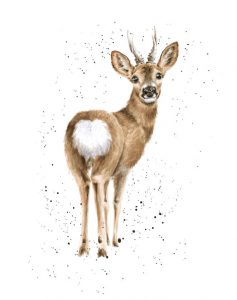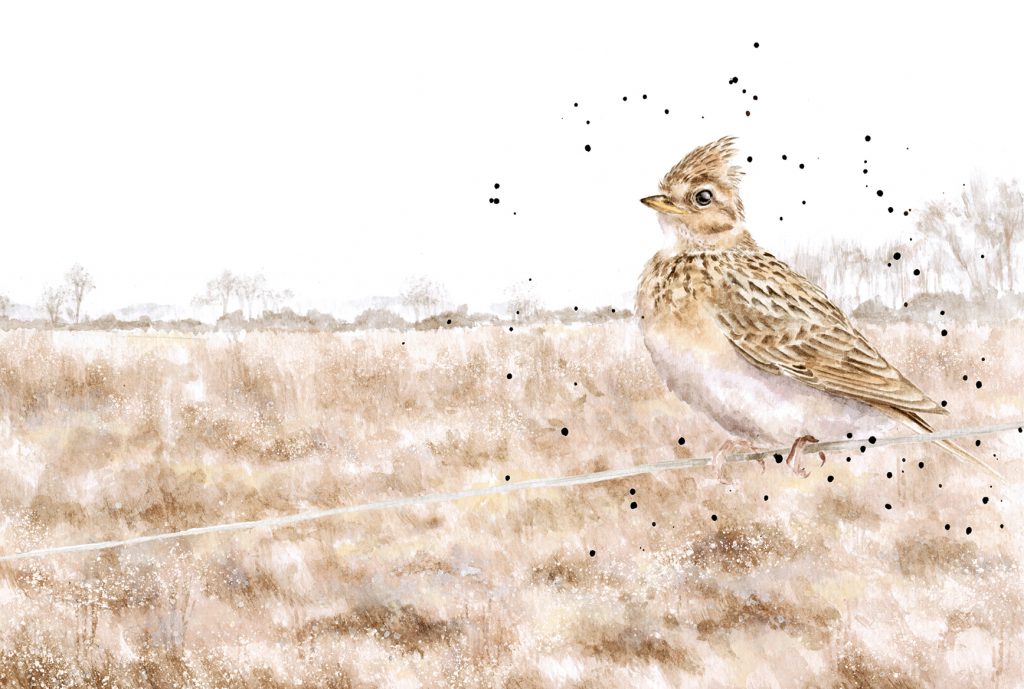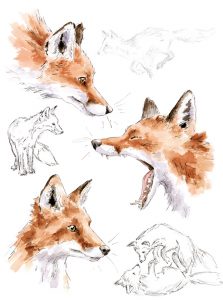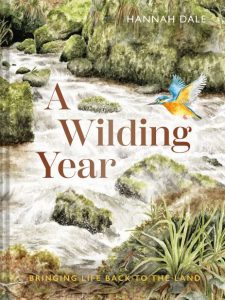Lincolnshire Today caught up with Hannah Dale, a wildlife illustrator, founder of Wrendale Designs, and self-proclaimed “Lincolnshire girl at heart,” ahead of the publication of her new book, A WILDING YEAR: Bringing Life Back To The Land, an illustrated journal of a year during the ambitious rewilding project that Hannah and her husband have undertaken on their farm.
A self-proclaimed “Lincolnshire girl at heart,” Hannah Dale is a wildlife illustrator and founder of the award-winning stationery and gift design company, Wrendale Designs, specialising in watercolour illustrations. Having grown up in the countryside of rural Lincolnshire and influenced by the local landscape, Hannah admits she’s never wanted to be anywhere else. Her background has informed everything from establishing her business in North Lincolnshire to the county’s wildlife sparking her inspiration to start drawing animals.

With a deep connection to nature and a passion for ecology and conservation, in 2019 Hannah and her husband embarked on an ambitious rewilding project on their 300-acre farm in North Lincolnshire. We caught up with Hannah ahead of the publication of her new book A WILDING YEAR: Bringing Life Back To The Land, an impassioned and personal illustrated journal of a year during their rewilding journey. From the return of orchids to beavers becoming the most recently introduced animal to the farm — the first to return to Lincolnshire in 400 years — it is certainly an inspiring story, though not one without its challenges.
“One of the biggest challenges initially is that we didn’t really know what we were doing,” Hannah shared. “We just felt that the farm wasn’t suitable for producing food. The land that we’re on is incredibly heavy clay, it sits wet all winter and then in the summer, because it has generations of drainage underneath, it bakes very dry and hard.” Going through four years of unproductive arable farming, the farm had equally lost its value to wildlife, creating a “worst of all worlds” situation. This, however, pushed Hannah and her husband to go down a different route, coming to the conclusion it was the perfect candidate for rewilding — a process of restoring ecosystems to the point that nature can take care of itself.
Starting their own rewilding project would not be easy, with advice and support difficult to find. “People were just so shocked at what we were considering, especially in Lincolnshire,” Hannah explained. “It was so different from what anybody else was doing and really difficult to get the support, but over the last five years rewilding has definitely entered the mainstream more.” In A WILDING YEAR, Hannah details the struggles of dealing with differing opinions on the project — of which there were many for and against. Not deterred, her commitment to rewilding has seen nature rapidly respond. “We didn’t know what to expect from day one, but very quickly we started to see lots of new species on the farm that we’d never seen before, and them returning with quite significant abundance,” Hannah said. Birds are one of the animals thriving, including 40 nesting sites of Skylark across the farm which did not exist before, the return of lapwing, and lots of grey partridge. “We have birds on the red list [those of conservation concern], that are really struggling and coming back to the farm in large numbers. That has been absolutely amazing to see.”

Butterflies are also a star of the rewilding project, showcasing how nature can heal within a short space of time. “Somebody from the local village, who’s been very supportive of what we’re doing, has been surveying butterflies in our local area and around our farm for the past 30 years,” Hannah explained, “and he’s seen the number of species decline and decline from in the twenties to 13 different species. Within two or three years of letting the scrub start to develop on the farm, we did a butterfly survey and recorded 23 different species of butterfly! Within that incredibly short space of time, you can see recovery starting to happen. The lepidopterist who did the survey said it is probably one of the best sites in Lincolnshire for grassland butterflies. It is astonishing to me that we went from being one of the worst sites for arable farming in the county to one of the best sites for grassland butterflies. It was an indication that we’re doing the right thing.”
One of the most exciting reappearances on the farm for Hannah, however, is orchids — now rare in our countrysides — due to the unique conditions it takes for them to grow. Hannah shared: “Last year we had common spotted orchid, pyramidal orchid and southern marsh orchid all growing on the farm. The reason that’s so exciting is because orchids produce seeds that are absolutely tiny. They’re like dust and they don’t have any resources within the seeds, so in order to be able to germinate they have to find a particular type of mycorrhizal fungus in the soil and then it forms this symbiotic relationship where the fungus feeds the seed and allows the plant to grow, and then as the plant becomes bigger, it can then supply sugars to the fungus. So, you can imagine when land is being farmed intensively it destroys the fungus within the soil and destroys these relationships. Starting to see the orchids growing on the farm again is an indication that that soil is starting to heal and some of those relationships are able to develop again.”
These wildlife wins are showcased in Hannah’s new book, A WILDING YEAR, the writing of which came naturally. “What we’re doing on the farm has provided so much more inspiration for my artwork,” she shared. “I find myself out there often with a sketchbook and recording what’s happening on the day-to-day basis on the farm through the art. That naturally then led to writing down some of those experiences and gave me the idea that actually this would make a really nice book. It’s part journal and part sketchbook and is filled with illustrations and lots of personal anecdotes and experiences of a year on the farm and through our rewilding journey.”

Hannah hopes the book will encourage people to see more beauty in wildness and understand that gardens don’t have to be neat and tidy spaces: “If we can leave our grass to grow a little bit longer, leave wild areas around the margins, stop using pesticides in the garden, it would make such a big difference to wildlife and we’d start to see more and more butterflies, hedgehogs and birds in our domestic spaces.” She added: “If I can play a little part in trying to restore nature and inspire people in Lincolnshire to do something similar, what a legacy. I’d be so proud to be able to do that.” For those who may want to follow in her footsteps and begin their own rewilding project, Hannah advised to “just go for it.” She said: “It doesn’t matter what scale you do it on, just follow the general principles of embracing wild, native plants and letting things grow and look a little bit untidy. It will absolutely encourage more wildlife into those spaces. There aren’t any hard and fast rules — that’s the other great thing about rewilding.”
With the rewilding of the farm well underway, Hannah is stepping back and letting nature take its course — for the most part: “The principle of rewilding is trying to let nature take the lead, but as we’re on 300 acres there are always going to be interventions that we need to do; playing those proxy roles of the animals that are missing from the landscape, like the large herbivores that once roamed and shaped it.” This includes digging holes as a proxy for a bull pit for when there were big aurochs, an extinct type of wild cattle, roaming the landscape. Hannah continued: “Largely it is a project where we can sit back and see what happens. We introduced beavers into the site just over a year ago and it’s exciting and interesting to see what they’re able to do in terms of creating wetlands and shaping the landscape, so there’s a lot of standing back and watching everything happen.” The introduction of the beavers marks the first in Lincolnshire in 400 years, having been native to the country but eradicated for meat, fur and castoreum.
The progress on the farm is “just the tip of the iceberg in terms of what is to come,” however. Hannah is enjoying the journey rather than aiming for a goal or endpoint: “I’m sure that there’ll be surprises, you never know what’s going to come next, which is really exciting.”
An inspiring account of how, in a time of climate breakdown, nature can thrive when given the chance, A WILDING YEAR: Bringing Life Back To The Land is out now, with all the royalties Hannah receives from writing the book going back into the nature recovery project.
See this interview in the April issue of Lincolnshire Today Magazine, here.
| For a chance to win one of five free copies of A WILDING YEAR: Bringing Life Back To The Land by Hannah Dale, send an email to competitions@blmgroup.co.uk answering the following question: What animal has Hannah recently introduced to the farm, the first to return to Lincolnshire in 400 years? |



